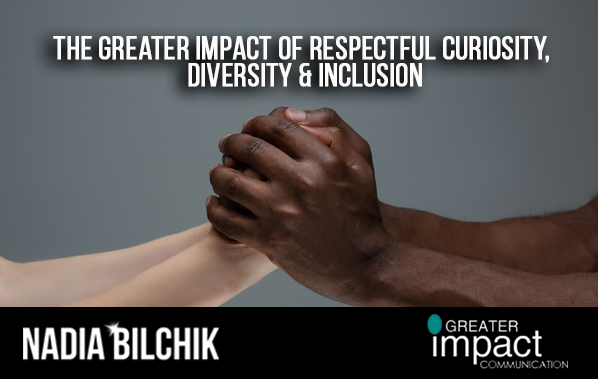
One of my most popular workshops focuses on Networking to Enhance a Diverse and Inclusive Business Environment. And it’s popular for a good reason: being able to successfully navigate relationships with individuals from diverse cultures, backgrounds and generations is essential both for you and your organization.
Doing business overseas has allowed U.S.-based companies to capitalize on rapid growth in emerging markets like China, India, and Latin America, and to earn much stronger profits than they would if they were totally dependent on the U.S. economy. In fact, almost half of the profits of companies in the Fortune 500 now come from overseas.
On a more local level, diverse populations are becoming increasingly affluent, and compose an important part of the market for goods and services. U.S Census data predicts that there will be no racial or ethnic majority by 2045 and that by 2050, 1 in 3 people living in the U.S. will be Hispanic. Also, by 2020, members of Generation Y/Millenials (born 1980-1994) will make up 50% of the workforce and by 2025, 3 out of every 4 workers around the globe will be Generation Y/Millenials.
Our definition of diversity encompasses both the traditional categories, like gender, ethnicity and age, as well as additional characteristics, like religious beliefs, military experience, and parental status. This can make for a complex environment to navigate, especially because many of us have an innate tendency to stereotype. But overriding this is both personally rewarding and a business imperative. According to Dr. Joy DeGruy, an inclusion and diversity expert, fostering a multicultural staff has become a necessity both in business and personal life. We will be very limited both personally and professionally if we can only form relationships with people with whom we don’t have to make an effort to connect.
“If we don’t intentionally include, we unintentionally exclude. The power of diversity thrives in a culture of inclusion.” ~Corey L. Jamison and Frederick A. Miller, The Linkage Leader: 7 Actions for Creating an Inclusive Organization
The reality is, whether you work for Coca-Cola, Home Depot, CNN, Turner Entertainment Networks, SalesLoft, SalesForce, Mercedes, Porsche, ESPN,Georgia Tech, Society of CPAs, Equifax, Southern Company, or yourself, the ability to understand, appreciate, and network with individuals whose life experiences may be different from yours is absolutely critical to your success.
Working for CNN, which has both local and international divisions, I am constantly reminded of the critical importance of diversity. For example, during the pope’s recent visit to the United States, the producers tapped in to the expertise of my Catholic colleagues who knew exactly when it was appropriate to take a commercial break during the Mass and when it may have appeared insensitive.
So the question is, how skilled are you at building relationships in a diverse business environment, and more to the point, do you maximize every opportunity? Let’s start with what stops us.
In my workshops from Dubai to Durban, I hear the same explanations for why some of us fail to network in diverse environments. These range from “deep-seated prejudices” to “I don’t have time” to “I don’t know how to do it.” In most cases, the responses reveal the very human tendency to profile, box and fit individuals into categories in one’s mind. So what you want to do is acknowledge that you have those impulses, and then override them in order to really see those whose backgrounds are different from your own as human beings. Then you can get to know each and every person you work with in a more profound way.
Do we make the effort to understand each other’s worlds, to really make friends with people who may at first glance appear so different from ourselves? Do we know the names of their children, and the biggest challenges they are facing? You may be surprised to learn that your workaholic colleague from a Latin American country is expected to support a large extended family back home, or that your seemingly demure Asian colleague comes from a culture where questioning the decisions and orders of a superior is simply not done.
I am fortunate to work with a very multi-faceted and diverse team both at CNN and in my training and speaking, so I have had the privilege of getting to know people not as stereotypes, but as individuals, and that is a great way to start.
You have to see people beyond the cardboard cutouts that they may represent to you. You will soon realize that there is much more to each individual than his or her “label.” More importantly, people can sense it when you’re not fully seeing them, and if that’s the case, they may be experiencing quite painful and resentful emotions. Needless to say, this does not help to foster workplace harmony and productivity, or, as Dr. Joy points out, contribute to retaining staff whose multicultural expertise is vital for your business success.
So, how do you reach out to people in a way that demonstrates you have a genuine interest in them beyond their “identity?”
One approach is to look for commonalities and to try to see the world that an individual from a different culture inhabits. For example, at a recent presentation in San Francisco, I was faced with the task of developing relationships with a group of men in their 30s. How did I reach them? They were all very interested in sports, so I made sure I knew what teams they were likely to be rooting for. If I have a Hispanic audience, I share my addiction to some riveting Latin American crime dramas that are currently available on Netflix. I also speak about my interest in how Spanish differs from region to region.
In cases where the commonalities may be less obvious, I ask people how their culture is different from mine, which typically yields very interesting results. For example, one woman from China revealed how she had to adjust to American culture by being more direct and speaking up more. I was also fascinated to learn how business and hierarchical cultures differ from country to country. And then you can always ask for ethnic food recommendations, which most people are happy to share, particularly when you are visiting an area you are not familiar with.
“Talking about differences can be hard. We’re so afraid we’ll make an erroneous assumption or say something offensive that any natural curiosity we feel toward another is stifled. Respectful inquisitiveness is one of the hallmarks of flexing to bridge the differences gap.” ~Jane Hyun and Audrey S. Lee, Flex: The New Playbook for Managing Across Differences
Then there is also the challenge of responding if you sense that you someone is stereotyping you. Dr. Joy suggests that your first task is to work to change that person’s perception by not appearing to be angry or offended. Still, there are those people who unfortunately will never see us for who we are. In that case, she suggests, the thing to do is to recognize their limitations and not take their behavior personally.
And so I challenge us all, every day to see the value that different perspectives bring, and then to build real, meaningful relationships with as diverse a group of people as possible. The result, I guarantee, will be an enormously enriched personal and professional life!



